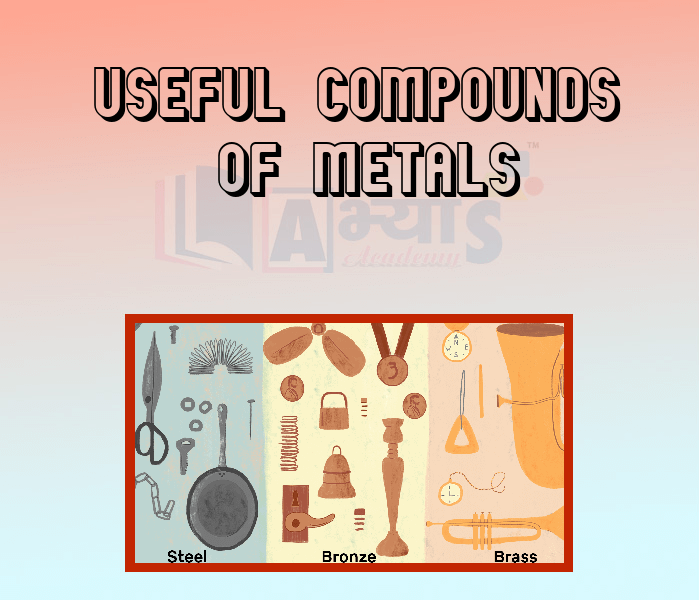Useful Compounds Of Metals










Useful Compounds Of Metals
Some Useful Compounds of Metals: Common Salt: Common salt is sodium chloride (NaCl). Common salt, when kept open, absorbs moisture from air. This is because of the presence of magnesium chloride in common salt. Magnesium chloride is deliquescent, that is, it absorbs water.
Sodium chloride is very important chemical. It is an essential ingredient in our daily meal. It can be converted into useful chemicals like caustic soda, washing soda and baking soda. It also yields hydrochloric acid, an important chemical used in chemical industry, and chlorine, which is used as a bleaching agent.
Caustic Soda: Chemically, caustic soda is sodium hydroxide (NaOH). It is obtained by electrolysis of brine (NaCl solution).
Washing Soda: Washing soda is sodium carbonate decahydrate . Sodium carbonate (soda ash) is alkaline in nature and has detergent (cleaning) properties. In a crystalline state, it possesses water crystallisation. On exposure to air, crystals lose water and turn into white opaque powder. Sodium carbonate is used as a cleansing agent for domestic purposes. It is also used for softening of hard water, in manufacturing of chemical like borax, caustic soda, glass and water glass. It is a constituent of many dry soap powders.
Baking Soda: The chemical name of baking soda is sodium hydrogen carbonate (). Sodium bicarbonate is used in the manufacture of baking powders and health salts.
Lime Calcium oxide is commonly known as quicklime or just lime. It is prepared by heating limestone () in a kiln.Calcium oxide reacts vigorously with water producing slaked lime [
], which is used for making mortar and for white washing.
A solution of slaked lime is known as lime water, which is used for testing carbon dioxide. Calcium oxide is used for making cement and glass.
Bleaching Powder: The chemical name of bleaching powder is calcium oxychloride (). Bleaching powder is commonly used for bleaching in laundries. It is used in paper and textile industries, for disinfecting water and preparation of chloroform.
Plaster of Paris: It is a calcium sulphate hemihydrate [].
Faster of Paris has a remarkable property of hardening when mixed with proper quantity of water.The hardening of Plaster of Paris is due to its hydration to form gypsum. It is used in the laboratories for sealing the gaps, where sunlight arrangement is required. It is also used for making casts for statues, and in surgery to maintain joints in a fixed position.
Students / Parents Reviews [20]
It was good as the experience because as we had come here we had been improved in a such envirnment created here.Extra is taught which is beneficial for future.

Eshan Arora
8thAbhyas Methodology is very good. It is based on according to student and each child manages accordingly to its properly. Methodology has improved the abilities of students to shine them in future.

Manish Kumar
10thAbhyas is a complete education Institute. Here extreme care is taken by teacher with the help of regular exam. Extra classes also conducted by the institute, if the student is weak.

Om Umang
10thIt was a good experience with Abhyas Academy. I even faced problems in starting but slowly and steadily overcomed. Especially reasoning classes helped me a lot.

Cheshta
10thMy experience with Abhyas academy is very nice or it can be said wonderful. I have been studying here from seven class. I have been completing my journey of three years. I am tinking that I should join Abhyas Academy in tenth class as I am seeing much improvement in Maths and English

Hridey Preet
9thMy experience with Abhyas is very good. I have learnt many things here like vedic maths and reasoning also. Teachers here first take our doubts and then there are assignments to verify our weak points.

Shivam Rana
7thBeing a parent, I saw my daughter improvement in her studies by seeing a good result in all day to day compititive exam TMO, NSO, IEO etc and as well as studies. I have got a fruitful result from my daughter.

Prisha Gupta
8thMy experience with Abhyas academy is very good. I did not think that my every subject coming here will be so strong. The main thing is that the online tests had made me learn here more things.

Hiya Gupta
8thThe experience was nice. I studied here for three years and saw a tremendous change in myself. I started liking subjects like English and SST which earlier I ran from. Extra knowledge gave me confidence to overcome competitive exams. One of the best institutes for secondary education.

Aman Kumar Shrivastava
10thMy experience with Abhyas Academy has been very good. When I was not in Abhyas whenever teacher ask questions I could not speak it confidently but when I came in Abhyas, my speaking skills developed and now I am the first one to give the answer of teachers question.

Upmanyu Sharma
7thUsually we see institutes offering objective based learning which usually causes a lag behind in subjective examinations which is the pattern followed by schools. I think it is really a work of planning to make us students grab the advantages of modes of examination, Objective Subjective and Onli...

Anika Saxena
8thAbhyas institute is one of the best coaching institute in the vicinity of Ambala Cantt area. The teachers of the institute are well experienced and very helpful in solving the problems of the students.The good thing of the institute is that it is providing extra classes for the students who are w...

Aman Kumar Shrivastava
10thIn terms of methodology I want to say that institute provides expert guidence and results oriented monitering supplements by requsite study material along with regular tests which help the students to improve their education skills.The techniques of providing education helps the students to asses...

Aman Kumar Shrivastava
10thOne of the best institutes to develope a child interest in studies.Provides SST and English knowledge also unlike other institutes. Teachers are co operative and friendly online tests andPPT develope practical knowledge also.

Aman Kumar Shrivastava
10thAbout Abhyas metholodology the teachers are very nice and hardworking toward students.The Centre Head Mrs Anu Sethi is also a brilliant teacher.Abhyas has taught me how to overcome problems and has always taken my doubts and suppoeted me.

Shreya Shrivastava
8thAbhyas is good institution and a innovative institute also. It is a good platform of beginners.Due to Abhyas,he has got knoweledge about reasoning and confidence.My son has improved his vocabulary because of Abhyas.Teacher have very friendly atmosphere also.

Manish Kumar
10thA marvelous experience with Abhyas. I am glad to share that my ward has achieved more than enough at the Ambala ABHYAS centre. Years have passed on and more and more he has gained. May the centre flourish and develop day by day by the grace of God.

Archit Segal
7thAbhyas is an institute of high repute. Yogansh has taken admission last year. It creates abilities in child to prepare for competitive exams. Students are motivated by living prizes on basis of performance in Abhyas exams. He is satisfied with institute.

Yogansh Nyasi
7thWhen I have not joined Abhyas Academy, my skills of solving maths problems were not clear. But, after joining it, my skills have been developed and my concepts of science and SST are very well. I also came to know about other subjects such as vedic maths and reasoning.

Sharandeep Singh
7thAbhyas institute is one of the best coaching institute in the vicinity of Ambala cantt.The institute provides good and quality education to the students.The teachers are well experienced and are very helpful in solving the problems. The major advantages of the institute is extra classes for weak...
